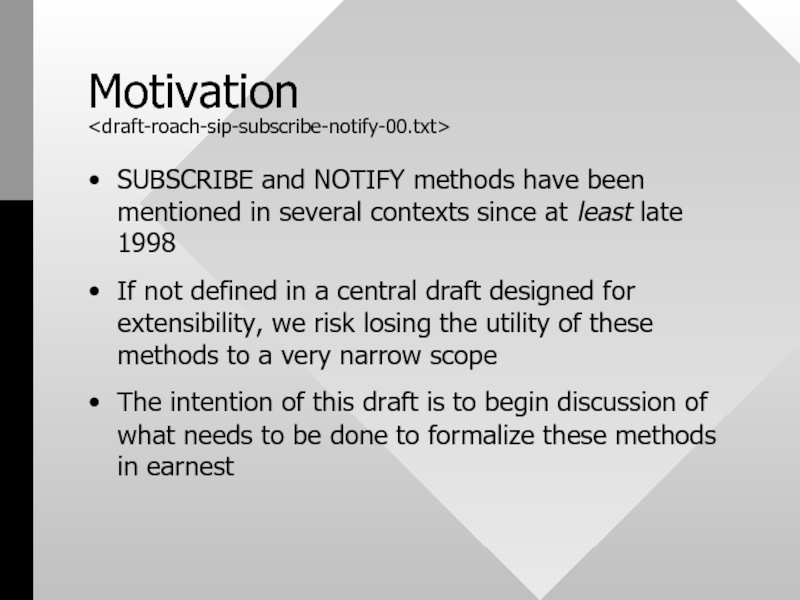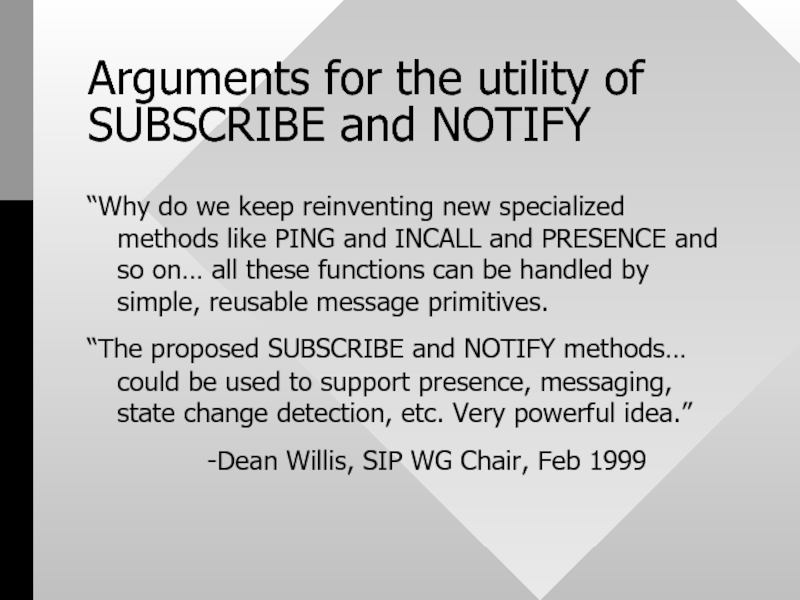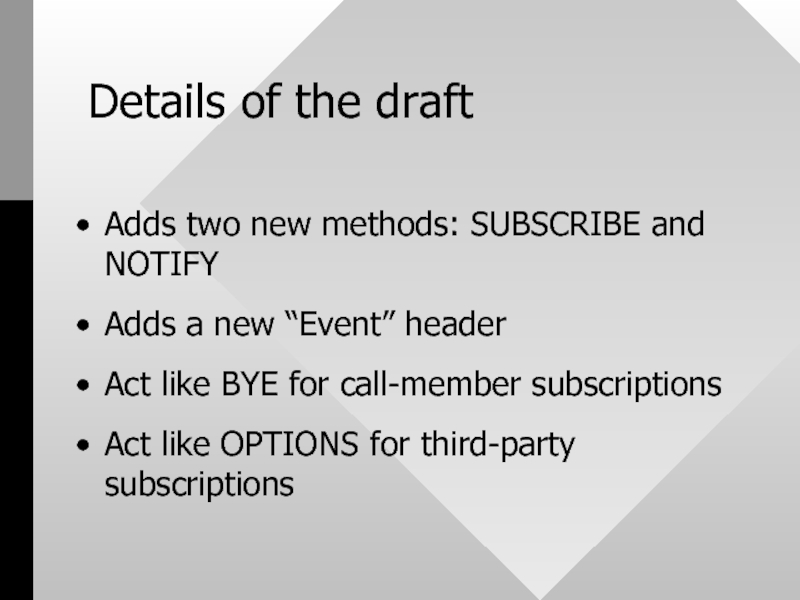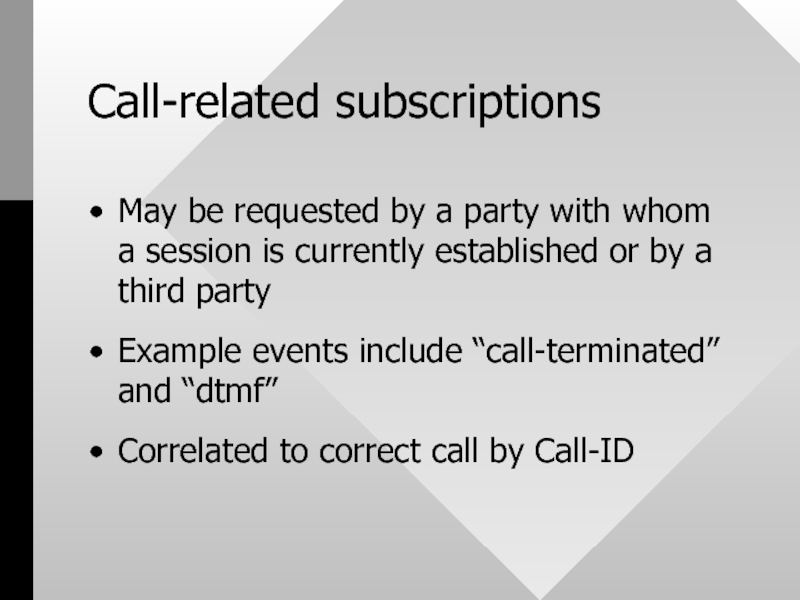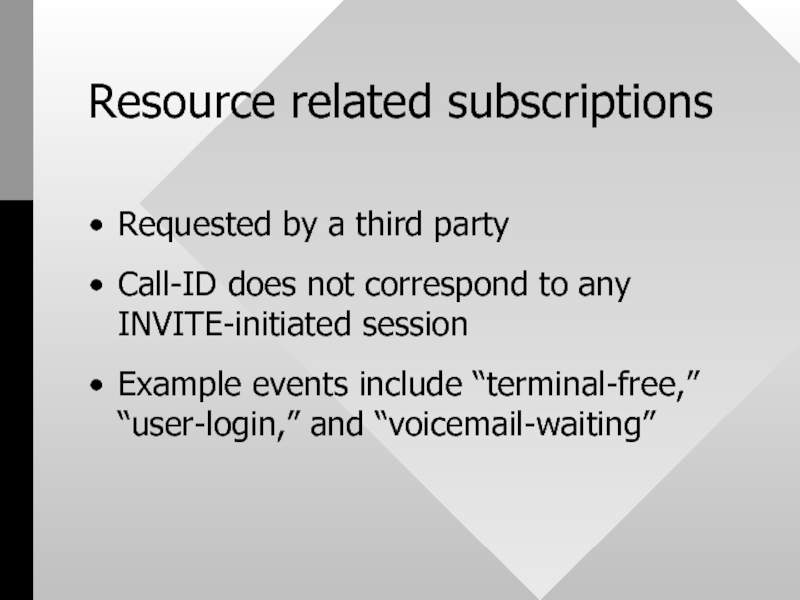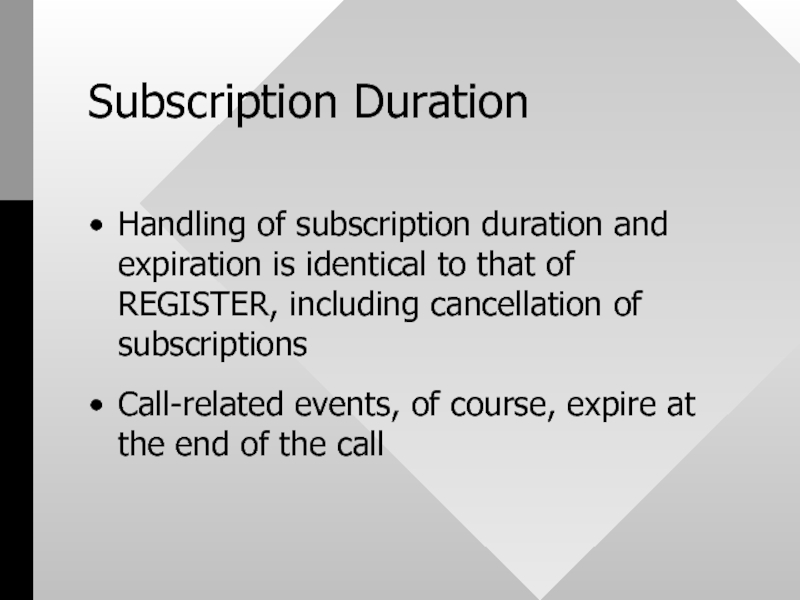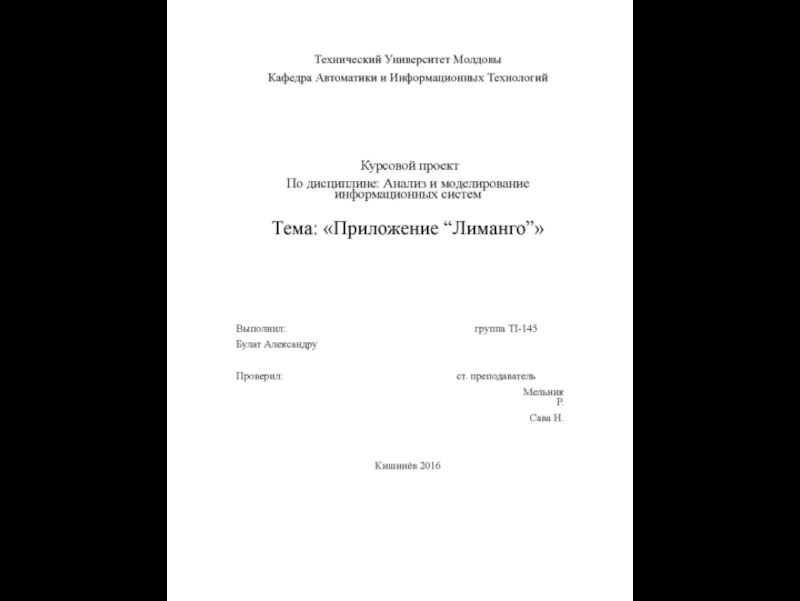- Главная
- Разное
- Дизайн
- Бизнес и предпринимательство
- Аналитика
- Образование
- Развлечения
- Красота и здоровье
- Финансы
- Государство
- Путешествия
- Спорт
- Недвижимость
- Армия
- Графика
- Культурология
- Еда и кулинария
- Лингвистика
- Английский язык
- Астрономия
- Алгебра
- Биология
- География
- Детские презентации
- Информатика
- История
- Литература
- Маркетинг
- Математика
- Медицина
- Менеджмент
- Музыка
- МХК
- Немецкий язык
- ОБЖ
- Обществознание
- Окружающий мир
- Педагогика
- Русский язык
- Технология
- Физика
- Философия
- Химия
- Шаблоны, картинки для презентаций
- Экология
- Экономика
- Юриспруденция
Event Notification in SIP SUBSCRIBE and NOTIFY and an example service презентация
Содержание
- 1. Event Notification in SIP SUBSCRIBE and NOTIFY and an example service
- 2. Motivation SUBSCRIBE and NOTIFY methods have
- 3. Arguments for the utility of SUBSCRIBE and
- 4. Details of the draft Adds two new
- 5. Call-related subscriptions May be requested by a
- 6. Resource related subscriptions Requested by a third
- 7. Notification Always share same remote-URI, local-URI, and
- 8. Subscription Duration Handling of subscription duration and
- 9. Getting along with the neighbors Efforts taken
- 10. Example Service: “Auto-Redial” Terminal requesting service
- 11. Open Questions Should the base SUBSCRIBE/NOTIFY draft
Слайд 1Event Notification in SIP
SUBSCRIBE and NOTIFY
and an example service
Adam Roach
Ericsson Inc.
adam.roach@ericsson.com
Слайд 2Motivation
SUBSCRIBE and NOTIFY methods have been mentioned in several contexts since
at least late 1998
If not defined in a central draft designed for extensibility, we risk losing the utility of these methods to a very narrow scope
The intention of this draft is to begin discussion of what needs to be done to formalize these methods in earnest
If not defined in a central draft designed for extensibility, we risk losing the utility of these methods to a very narrow scope
The intention of this draft is to begin discussion of what needs to be done to formalize these methods in earnest
Слайд 3Arguments for the utility of SUBSCRIBE and NOTIFY
“Why do we keep
reinventing new specialized methods like PING and INCALL and PRESENCE and so on… all these functions can be handled by simple, reusable message primitives.
“The proposed SUBSCRIBE and NOTIFY methods… could be used to support presence, messaging, state change detection, etc. Very powerful idea.”
-Dean Willis, SIP WG Chair, Feb 1999
“The proposed SUBSCRIBE and NOTIFY methods… could be used to support presence, messaging, state change detection, etc. Very powerful idea.”
-Dean Willis, SIP WG Chair, Feb 1999
Слайд 4Details of the draft
Adds two new methods: SUBSCRIBE and NOTIFY
Adds a
new “Event” header
Act like BYE for call-member subscriptions
Act like OPTIONS for third-party subscriptions
Act like BYE for call-member subscriptions
Act like OPTIONS for third-party subscriptions
Слайд 5Call-related subscriptions
May be requested by a party with whom a session
is currently established or by a third party
Example events include “call-terminated” and “dtmf”
Correlated to correct call by Call-ID
Example events include “call-terminated” and “dtmf”
Correlated to correct call by Call-ID
Слайд 6Resource related subscriptions
Requested by a third party
Call-ID does not correspond to
any INVITE-initiated session
Example events include “terminal-free,” “user-login,” and “voicemail-waiting”
Example events include “terminal-free,” “user-login,” and “voicemail-waiting”
Слайд 7Notification
Always share same remote-URI, local-URI, and Call-ID as SUBSCRIBE to which
they correspond (same correlation as a session).
Contain a single event in the Event header
May contain other event-related parameters (as new headers or message body)
Contain a single event in the Event header
May contain other event-related parameters (as new headers or message body)
Слайд 8Subscription Duration
Handling of subscription duration and expiration is identical to that
of REGISTER, including cancellation of subscriptions
Call-related events, of course, expire at the end of the call
Call-related events, of course, expire at the end of the call
Слайд 9Getting along with the neighbors
Efforts taken to not disrupt the PINT-defined
SUBSCRIBE and NOTIFY: if no “Event” header is present, clients can assume “all events” (as in PINT)
Client can trivially support both drafts simultaneously
May make sense to combine event notification efforts into a single, merged draft
Client can trivially support both drafts simultaneously
May make sense to combine event notification efforts into a single, merged draft
Слайд 10Example Service: “Auto-Redial”
Terminal requesting service subscribes to “terminal-free” event
When the called
party’s terminal has no ongoing calls, calling party receives notification
New INVITE is then issued to start a session
Chosen as example because existing SIP methods of providing this service are sub-optimal
Contains very detailed callflows of SUBSCRIBE and NOTIFY in action
New INVITE is then issued to start a session
Chosen as example because existing SIP methods of providing this service are sub-optimal
Contains very detailed callflows of SUBSCRIBE and NOTIFY in action
Слайд 11Open Questions
Should the base SUBSCRIBE/NOTIFY draft go further in defining a
base set of events?
Is there sufficient interest in the types of services these methods provide to proceed with this work?
Should the draft be expanded to allow subscriptions to events at proxies and other non-user-agent nodes?
How should we proceed with coordination with PINT?
How should expirations be handled for multiple events requested in a single SUBSCRIBE message?
Is there sufficient interest in the types of services these methods provide to proceed with this work?
Should the draft be expanded to allow subscriptions to events at proxies and other non-user-agent nodes?
How should we proceed with coordination with PINT?
How should expirations be handled for multiple events requested in a single SUBSCRIBE message?

